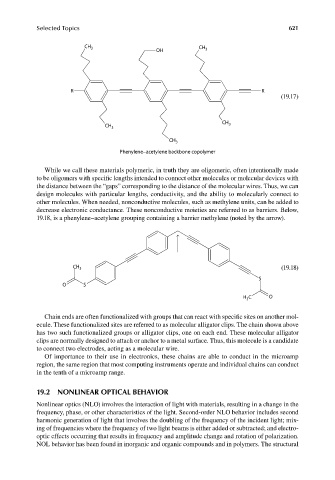Page 658 - Carrahers_Polymer_Chemistry,_Eighth_Edition
P. 658
Selected Topics 621
CH 3 CH
OH 3
R R
(19.17)
CH
CH 3 3
CH 3
Phenylene−acetylene backbone copolymer
While we call these materials polymeric, in truth they are oligomeric, often intentionally made
to be oligomers with specific lengths intended to connect other molecules or molecular devices with
the distance between the “gaps” corresponding to the distance of the molecular wires. Thus, we can
design molecules with particular lengths, conductivity, and the ability to molecularly connect to
other molecules. When needed, nonconductive molecules, such as methylene units, can be added to
decrease electronic conductance. These nonconductive moieties are referred to as barriers. Below,
19.18, is a phenylene–acetylene grouping containing a barrier methylene (noted by the arrow).
CH 3 (19.18)
S
O S
H C O
3
Chain ends are often functionalized with groups that can react with specific sites on another mol-
ecule. These functionalized sites are referred to as molecular alligator clips. The chain shown above
has two such functionalized groups or alligator clips, one on each end. These molecular alligator
clips are normally designed to attach or anchor to a metal surface. Thus, this molecule is a candidate
to connect two electrodes, acting as a molecular wire.
Of importance to their use in electronics, these chains are able to conduct in the microamp
region, the same region that most computing instruments operate and individual chains can conduct
in the tenth of a microamp range.
19.2 NONLINEAR OPTICAL BEHAVIOR
Nonlinear optics (NLO) involves the interaction of light with materials, resulting in a change in the
frequency, phase, or other characteristics of the light. Second-order NLO behavior includes second
harmonic generation of light that involves the doubling of the frequency of the incident light; mix-
ing of frequencies where the frequency of two light beams is either added or subtracted; and electro-
optic effects occurring that results in frequency and amplitude change and rotation of polarization.
NOL behavior has been found in inorganic and organic compounds and in polymers. The structural
9/14/2010 3:43:50 PM
K10478.indb 621 9/14/2010 3:43:50 PM
K10478.indb 621

